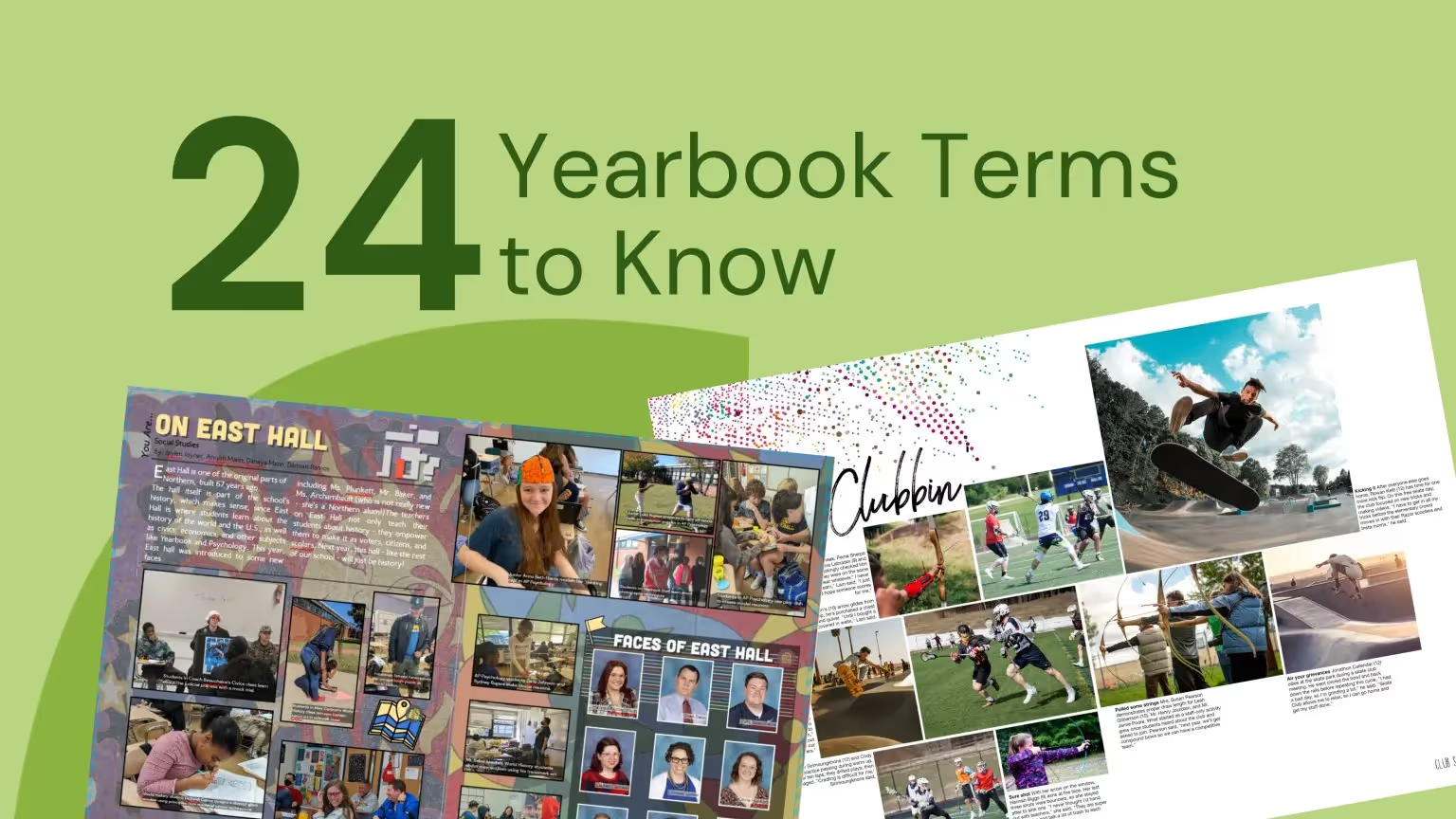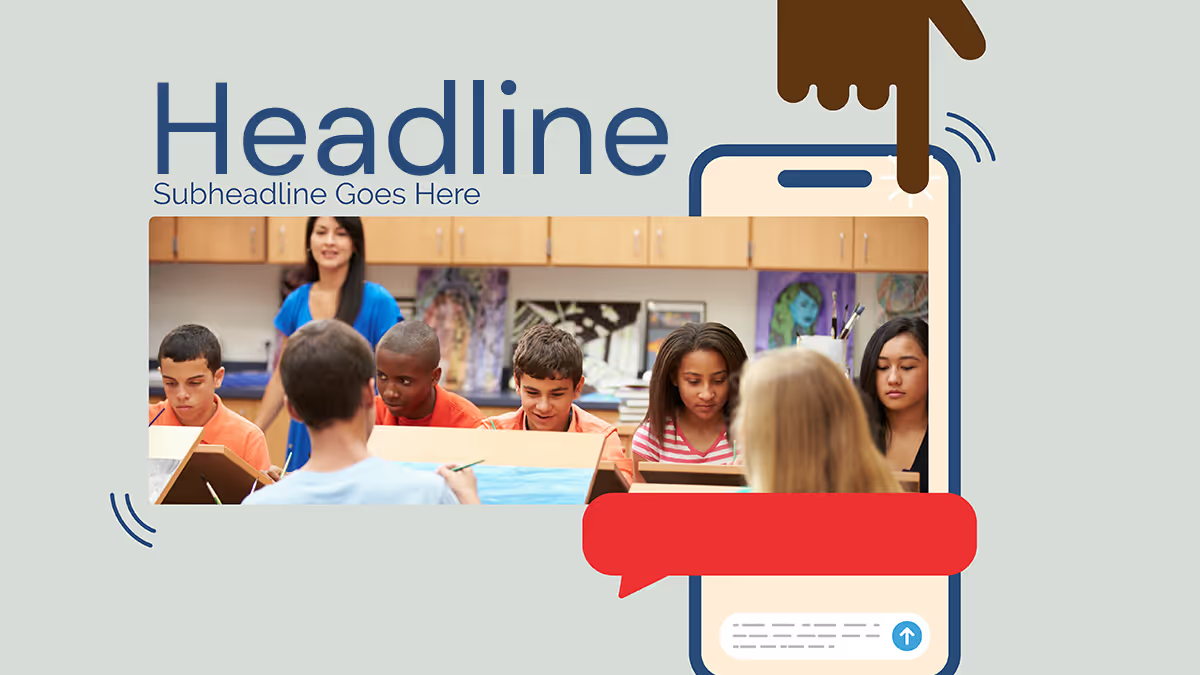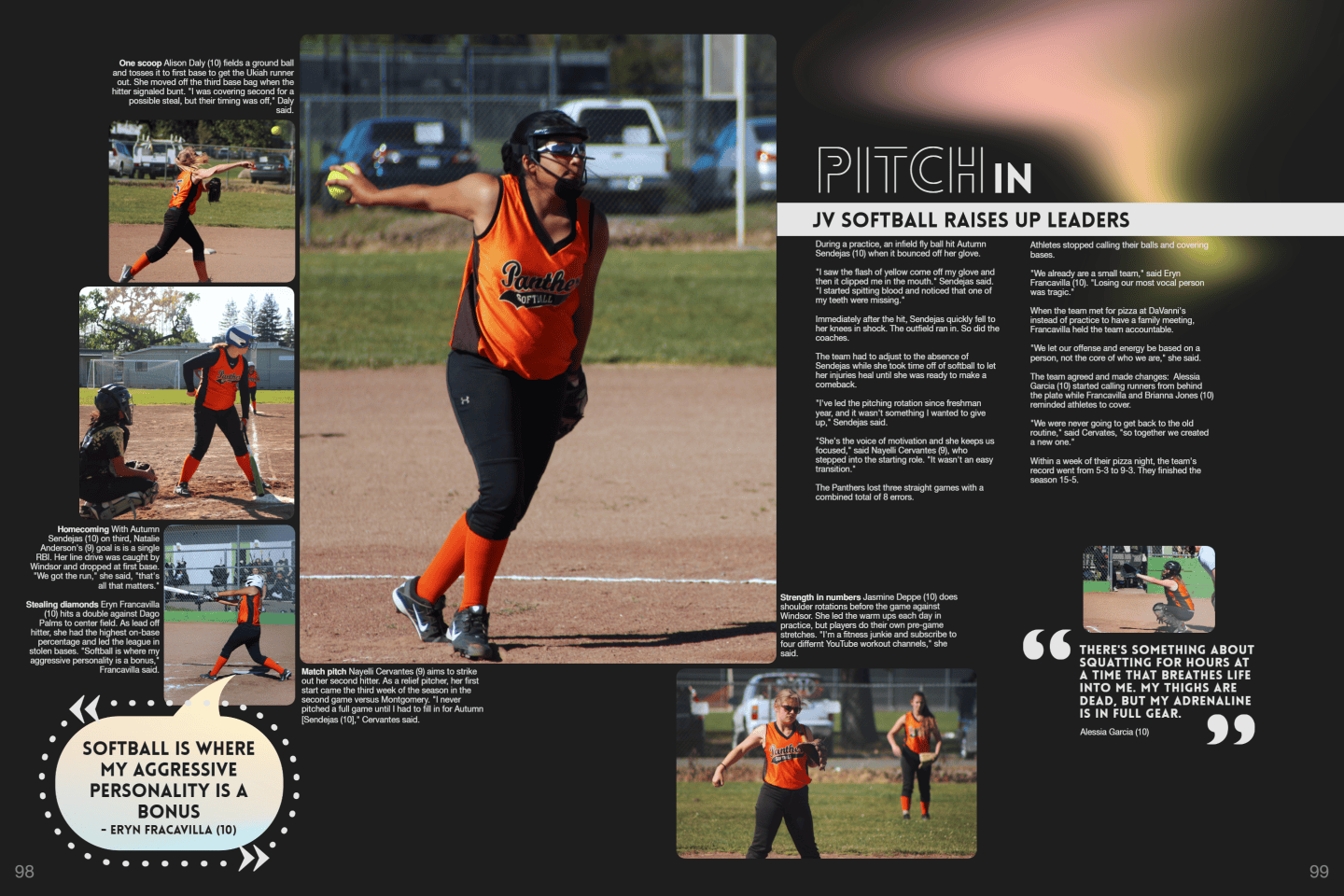Writing
Looking for inspiration, design tricks, how to make a great cover, promoting your yearbook and engaging your community?
Most recent

Using the "five common topics" for yearbook copy
The inverted pyramid is the go-to launch point for budding journalists. (Anyone else hear a journalism teacher’s voice: “Don’t bury the lede!”) For these emerging writers, filling each level equates to squeezing the five Ws into its ranks. This could lead to repetitive or restricted writing. The “easy” fix: asking better questions.

Integrating the five common topics with the inverted pyramid structure helps students create engaging yearbook copy because it models inquiry. They move beyond “What was your favorite…?” They create questions with analytical depth. They craft stories worth reading.
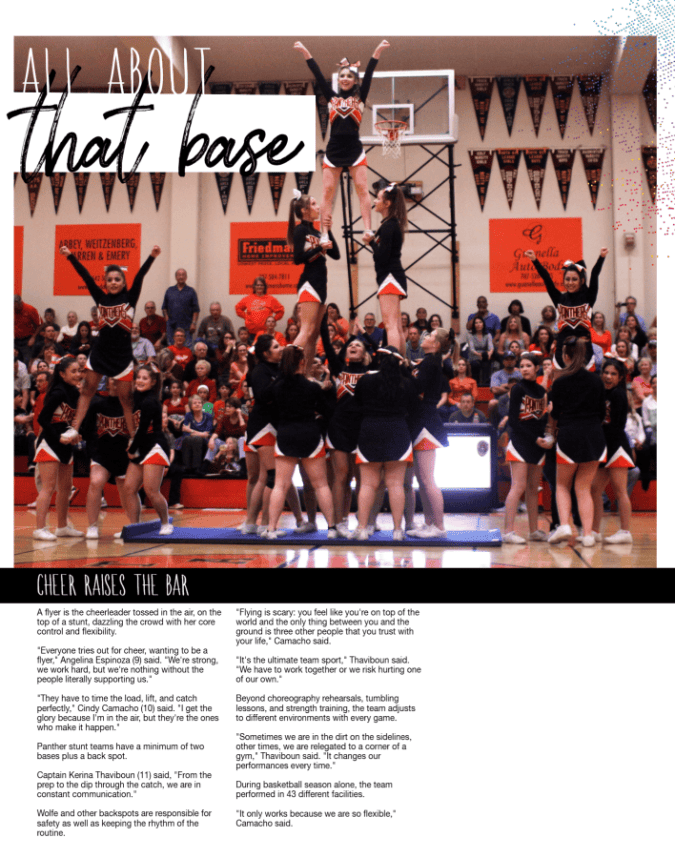
What are the five common topics?
How would the ancient Greek and Roman orators write a yearbook story? (That might as well be under “Adviser questions I’ll never ask for 1000, Alex.”) The five common topics are definition, comparison, relationship, circumstance, and testimony. The early scholars used this method of inquiry to discuss, persuade, and analyze. Developing yearbook interview questions based on the five common topics can be a structured way to gather information and insights.
Definition
The five Ws fall here: the topic of definition breaks down your subject into key components. What it is and who does it. Where it takes place. Why it’s important. When it occurs.
What is a clear definition of [the subject]?
This is extremely helpful for students when they craft copy on an unfamiliar topic. For example, most people use “bump, set, spike” somewhere on a volleyball spread. We don’t bump. We pass.
How would you characterize the key features that distinguish [the subject] from other similar concepts?
Each game, dance, movie night, and fun run is unique. So are labs, presentations, debates, and study sessions. Find out what sets this event or activity apart. By defining what it is holistically, you are also defining what it is not: just another day. (Remember, there is a reason for this story beyond an opening in your page template.)
What are the essential elements that makeup [the subject]?
Sports and arts copy can always be improved by understanding the technique. Start with your photos and ask the stakeholders to explain what they are doing step by step. Define tools, from cleat spikes to microscopes, and their use.

Back to our volleyball example: She’s aligning her feet to the setter and positioning her body so her belly button is behind the ball. Straight arms and little-to-no movement are key for her to give a high pass the setter can push to the outside hitters or run a quick hit from the middle. She starts each practice by passing 50 free balls as an offense-defense transition drill.
No bumping is involved.
Comparison
The next step is to expand upon the basics by drawing parallels or highlighting differences. Using analogies, journalism students can make complex ideas understandable. Sometimes, it helps to take the opposite approach and point out key differences.
In what ways is [the subject] similar to [another relevant entity], and how are they different?
Familiarity is comfortable. By relating new topics to known ones, you can ease your reader in.
Are there instances where lessons from [a related concept] can be applied to [the subject]?
Again, even though chemistry class repeats the gummy bear lab annually, it is not the same year after year. The same can be said about an AP class preparing their art portfolios or a Link Crew orientation.
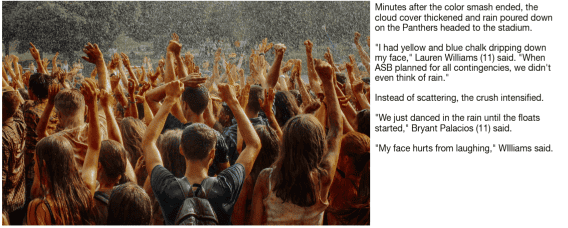
Using the topic of comparison, student reporters have a reason to cover recurring events–they are digging into the differences.
How does the comparison to [another relevant entity] enhance our understanding of [the subject]?
Keyword: enhance. Comparison is valuable if it adds value. And before you flinch at the intended redundancy, remember new writers need to evaluate their notes as part of their process. Listing related and opposing concepts will also strengthen the topic of definition.
Relationship and Circumstance (This is a Twofer)
I’m combining topics three and four. Event sequences, cause-and-effect relationships, and the outcome of the event all have a place at the proverbial table. Understanding circumstance helps in tailoring yearbook copy to be more relevant and effective because we use it to examine the context of each story. It’s the here and now. These details help readers understand why the event is significant at this moment.
What current events or trends are influencing [the subject]?
More than the water bottle du jour, the timeliness of a yearbook story gives its place in your school’s historical record. You give campus events context by relating them to the community or even the world.

Are there specific challenges or opportunities related to [the subject] that are particularly relevant now?
In the example above, a student gave a speech. This is a daily occurrence around the globe. The author used the subject’s reported challenges and testimony (spoiler alert: that’s topic #5) to illustrate what led to the moment.
Chances are, this story wouldn’t have been printed in your mom’s yearbook. The circumstance was different.
Can you identify any cause-and-effect relationships associated with [the subject]?
Part of contextualizing your yearbook stories is adding what resulted from the story. Did the fundraiser set a new record? Athlete return for her final game of the season? AP Language class win the literary food festival? Wrap up your story.
Testimony
“Give me a quote for the yearbook.” Next to definition, testimony is the most commonly used of the five common topics. It’s the human element. Including testimonies from different sources helps balance the story, gives authority to student writing, and showcases varied perspectives.
While it’s the fifth topic, when students write, they should incorporate the questions below.
What diverse perspectives contribute to a more comprehensive understanding of [the subject]?
Scores, stats, fundraising figures, and meaningful quotes enhance credibility and give voice to yearbook copy.
How do you navigate conflicting testimony or opinions from authoritative sources regarding [the subject]?
The short answer: ask more questions. How do you find out what is true and who do you ask? (This could be more common with sporting events over bio labs.)

Testimony: Add relevant quotes from participants or spectators to illustrate.
Relationship and Circumstance: Explain what factors led to the event and how it impacted the school community.
Testimony: End the story by adding additional quotes or data to add depth and credibility.
Example structure for the inverted pyramid and five common topics
Let’s start with this photograph of four students on the green.

To come up with the copy, students identified:
- Names of students and their grades
- Location of photo
- What is going on
- Background on Xilam
- What aspect of Xilam is shown in the image
- Relationships between Mexican martial arts and Spanish for native speakers class
- How many languages–and which ones–are spoken on campus
This structure delivers both the essential information layered with insights. It moves beyond a listing of the 5Ws because it begins with inquiry.

Caption this: writing tips for yearbook
Yearbook captions provide the context and information to help tell the story behind each photo. They explain what's happening, who is in the picture, and why it's significant. Without captions, many images may lose their meaning or context. Conversely, it is not a storytelling photo if you cannot write about it.
Try this: open your middle school yearbook and try to name all the people on page 24. Can you do it without looking at the captions?
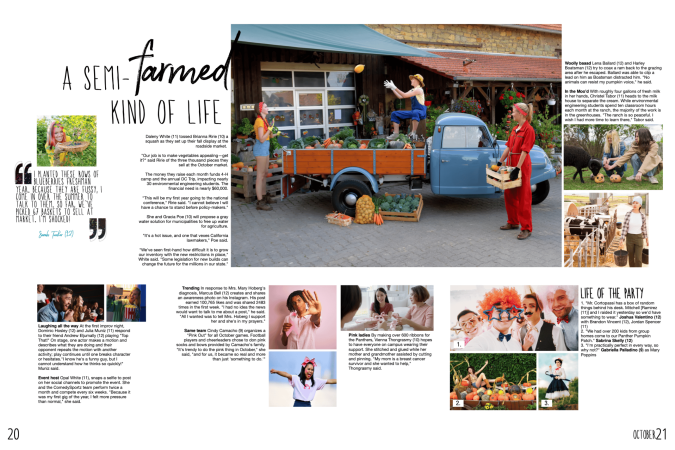
Three types of yearbook captions
Ident captions
Also, called ID captions, they do just that: identify who is in the photograph. Often used in photo collages, ident captions preserve the names of individuals for posterity and historical record. At a basic level, knowing the names of the individuals can make the yearbook content more personal and relatable, and, from a student’s point of view, their name equates to their mark on your campus community.
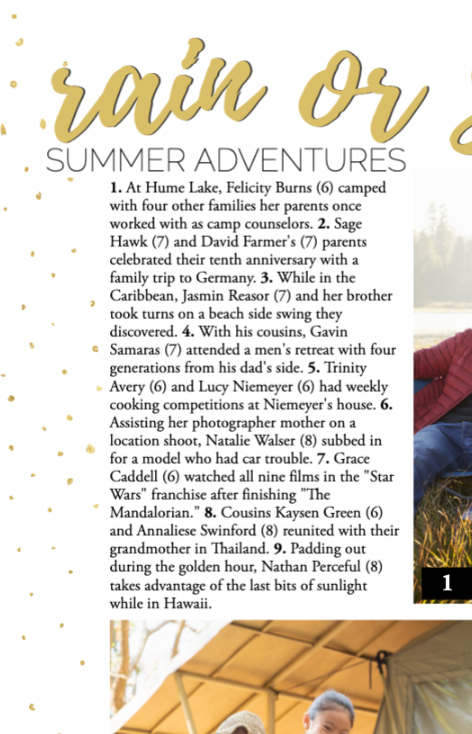

Summary captions
These captions tell a brief story or narrative related to the photo. They engage the reader by presenting the photo as part of a larger, unfolding story by answering who, what, when, why, where, and how in a sentence. Summary captions are always written in the present tense.
Start by being Captain Obvious and use the why and how to give readers more information.

Expanded captions
Writing an expanded caption for a yearbook involves providing more context and detail about the photo. It’s journalism. It requires practice. It’s a skill. Each expanded caption is a three-sentence story that adds depth to your spread and supports the whole year’s narrative.
Expanded captions have three parts, four if your yearbook has a lede.

How do I write expanded captions?
Because writing is a process, each of the following steps takes time and attention to be effective.
Step 1: observe and analyze the photograph
Identify key elements, people, objects, and actions using who, what, when, why, where, and how. Be sure to consider the emotions, expressions, and details within the foreground and background of the image.
Verify names and activities before moving to the second step.
Step 2: prepare interview questions
Use open-ended questions to gather more information, opinions, and insights from individuals. Find out what happened before and after the photograph and the relationships between the people in the image. Remember, it’s better to have to cut down content than scramble to fill space.
The goal of your interview is to provide additional context and meaning. Showing up and saying, “Give me a quote for the yearbook,” isn’t going to achieve that.
Step 3: put it all together

What not to do
Avoid editorializing and jokes. It’s not your job to critique what is happening (Romero’s awesome painting) or change the narrative (Is that Bob Ross? No, it’s Ezekiel Romero). Your job is to report. Quotes should be used to convey the feelings or reactions of the people involved.
Get more caption help with the writing module in Treering's free curriculum.
By adding captions—ident, summary, or expanded—you not only describe the photo, but also provide a deeper understanding of the moment and its significance, making your yearbook more engaging and informative.

Why you need evergreen content for yearbook
Like its namesake, evergreen content stays fresh for a long time, unlike the tie-dye loungewear we are still trying to forget. While you should definitely include polls and trends in your yearbook (it is the story of the year after all), open-ended interview questions (such as the 40+ we are giving you below) should remain in your repertoire for three reasons:
For ease of use, we organized these interview questions by yearbook section. Grab your editorial team and create your list!
Student Life
Because some of your formative moments occur outside the classroom, be sure to include all that goes into the school day.
Campus Life
Routine
People
These questions make great sidebars to go along your portrait pages.
Milestones
Interests
Academics
Athletics
Bonus: Trending Topics
Add content on the following to complement the evergreen content in your yearbook.
For even more interviewing tips, check out the yearbook storytelling module from Treering's free curriculum.

Teaching yearbook: 60 bell ringers
How different would your yearbook class or club be if you had ten minutes at the start to focus your team on the day's objectives and transition them from hallway to classroom mode? Working with middle and high school yearbook advisers, we created 60 Bell Ringers to do just this. Use the prompts below to teach and strengthen skills by dropping them in Google Classroom, displaying them in a slide deck, or writing them on the board.
- Why Do You Need Bell Ringers for Yearbook?
- Teambuilding
- Bell Ringers to Teach Writing
- What’s Happening Here?
- Brainstorming Bell Ringers
- Use These Bell Ringers to Model a Yearbook Critique
- Writing Prompts for Reflection
Why do you need bell ringers for yearbook?
While we often pump the intro to design and copywriting lessons the first few weeks of the school year, the overwhelming nature of organizing photo shoots, liaising with club sponsors or athletic coaches and scheduling picture day take precedence. (Validation: those things are vital for the success of your yearbook–keep doing them!)
If you’re submitting documentation for WASC or your admin, bell ringers activate learning by giving students a quick thought-provoking question, problem-solving exercise, or yearbook critique activity. Some bell ringers encourage critical thinking, and others serve as an anticipatory activity because they stimulate students’ curiosity.
TLDR? Use bell ringers to set the tone.
Teambuilding
Yes, you’ll have your group games, yearbook weddings, and human knots. And no, that’s not all you’ll need to forge connections and build trust. These prompts help students share and learn about each other’s interests, preferences, and experiences and teach empathy for those they’ll interview in the weeks ahead.
- “Emoji Introduction”: Share three emojis that represent different aspects of your life. (Afterward, students share their emojis with the class and explain their choices, providing insights into their personalities and experiences.)
- “Time Capsule”: Describe five things you would put in a time capsule for yearbook students 10 years from now.
- “Do-Over”: What is one thing you wish you had done differently this year and why?
- “Influencer”: Share a book, movie, or song that profoundly impacted you and explain why it resonated with you. (If appropriate, you may want to create a yearbook team playlist for motivation, or when it’s time to celebrate good times… come on!)
- “Self-Promotion”: What role does the yearbook play in fostering a sense of community and collective identity within the school? How are you contributing?
- “Dear Younger Me”: Reflect on your overall personal growth and development throughout your time on the yearbook staff and how it has shaped you as an individual. What did you wish you knew at the start of the year?
- “Mind Shift”: Describe a class or subject that you initially didn’t enjoy but ended up loving and why your perspective changed.
- “Second Life”: What is something you are proud of accomplishing outside of academics this year?
Bell ringers to teach writing
Quick math lesson: one five-minute writing bell ringer debrief a week will give your students an additional 200 minutes of writing practice. With these short writing tasks, advisers can also provide more immediate feedback to students when they share their work. Don’t think of it as an informal assessment that requires a line item in the grade book, but rather as facilitating continuous growth.
Ledes and captions
- What is the importance of a compelling lede in a piece of writing? Share an example of a lead that successfully captures your attention and explain why it stands out to you.
- Think about a memorable article or story you’ve read recently. Analyze the lede and discuss how it effectively hooks the reader and sets the tone for the rest of the piece.
- Choose a recent photo from your phone and write three possible ledes: one pun, one using your theme, and one three-word attention-grabber.
- Reflect on a nearly finished spread and revise at least one lede. Share how it improved the overall impact of your writing.
Feature stories
- Think about a significant moment or event from your school year that you believe would make a great yearbook story. Outline the key elements of the story, including the people involved, the emotions experienced, and the impact it had on the school community.
- List potential angles, interview questions, and storytelling techniques you would employ for a personality profile for a student you do not know.
- Interview another yearbook student about a personal experience or accomplishment from this school year. Write a brief summary of the story, including the central theme, key moments, and the message or lesson it conveys.
- Brainstorm ideas for a yearbook story that celebrates the diversity and inclusivity of your school community. Share potential story angles or interview questions that would help capture the richness of your school’s diversity.
- Have students gather in small groups and share one memorable experience or event from the school year. Each group should choose one story to develop further as a potential yearbook feature. Encourage them to discuss the key moments, people (directly and indirectly involved), emotions, and impact of the story.
- Provide students with a collection of unused photographs from a specific school activity. In pairs or individually, students should select one photo that catches their attention and write a brief story idea based on the image. Encourage them to consider the context, characters, and potential narrative elements.
- Organize a “Story Pitch” session where students can present their yearbook story ideas to the class. Each student should prepare a short pitch, explaining the central theme, key moments, and the significance of their chosen story. Encourage constructive feedback and discussion among the students.
What’s happening here?
These yearbook caption bell ringers work best when paired with a photo of a prominent event on campus or one from history or pop culture. The goal is to unpack the action and the story within the image. For consistent practice, make a weekly event, such as “Photo Friday,” to cycle through these prompts.
- List the who, what, when, where, why, and how of this photo.
- List 10 or more verbs to describe the subject’s action or state of being in this photo.
- List 10 or more emotions to describe the subject’s action or state of being in this photo.
- Create a caption using only emojis.
- Caption this in five words.
Do you need photo inspiration? We love the New York Times.
Brainstorming bell ringers
Sometimes a five-minute brain dump is all you need to break out of a slump.
- Looking at the school events calendar for the week, list different approaches you could take to cover each event in a table labeled before, during, and after.
- Design a unique “map” page showcasing the school campus and highlighting key locations, such as classrooms, the cafeteria, and outdoor spaces.
- Create a visual timeline of major school events throughout the year, using icons or symbols to represent each event.
- List 10 “hacks” that make school easier for you.
- Create a mini infographic showcasing interesting statistics or facts about an aspect of the school year.
- Design a series of icons or symbols to represent different academic subjects, extracurricular activities, clubs and organizations, and sports teams in the yearbook.
- Sketch a “Behind the Scenes” spread showcasing the yearbook team’s work so far.
- List teachers, labs, projects, field trips, and assignments that challenged you to think creatively or outside the box.
- [Display unused yearbook photos of note in a “Yearbook Story Idea” station.] Consider uncovered aspects of the school year and brainstorm three ways to get them in the yearbook.
Use these bell ringers to model a yearbook critique
Every student (and adviser) who helps produce the yearbook puts their work on display. No other group of students’ homework is hanging around 10, 20, or 50 years later like a yearbook. Boom. That said, use these critique prompts to reinforce positive comments.
- [Display a spread] Sketch the layout and identify each component (e.g. gutter and caption).
- List the elements we used to create a sense of unity and flow throughout the yearbook. What are there recurring visual motifs or elements that tie the pages together?
- [Display three spreads from your yearbook] Give five specific examples of how these spreads carry out our theme.
- Using an in-progress spread, give five examples of how your design connects to the remainder of the yearbook.
- [Display a spread] Sketch the layout. Identify the primary and secondary design elements and explain whether the hierarchy of information is clear.
- Reflect on a memorable moment from a previous yearbook. Analyze the elements that made the module, spread, or story engaging.
Two things:
- Start with examples of strong design from your students to highlight the wins.
- Keep it technical. When students use terms like eyeline, dominance, and alignment, there is a specific element to which we can attend versus “I don’t like it.”
Writing prompts for reflection
Sometimes, students need time and space to be introspective. These bell ringers are less about the how of yearbook and more about the why. After answering them in class, try using them for interview topics for other students to use in personality profiles or sidebars.
- If you could give one piece of advice to future students, what would it be and why?
- What is one thing you learned about yourself this year that you didn’t know before?
- Describe a moment when you felt proud of yourself and explain why it was significant to you.
- If you could choose one word to summarize your overall experience in this school, what would it be and why?
- Share a story about a time when you overcame a challenge or obstacle and what you learned from it.
- Describe a teacher or staff member with action words and explain how they influenced you.
- Share a funny or embarrassing moment that happened to you during the school year.
- Share a piece of advice you received from someone that changed your mind.
- If you could create a new school tradition, what would it be and why?
- Describe a time when you felt like you made a positive difference in someone else’s life.
- What is one thing you wish you had known as a freshman/sophomore/junior that you know now as a senior?
- Describe a moment when you felt like you truly belonged and were part of a community.
- If you could interview any historical figure, who would it be, and what five questions would you ask them?
- Share a piece of advice you would give to incoming freshmen and explain why you think it’s important.
- Reflect on a moment when you felt inspired or motivated by someone else’s actions or achievements.
- Share a quote or motto that has guided you throughout this school year and explain its significance to you.
- If you could go back and change one decision you made this year, what would it be and why?
- Describe a meaningful friendship.
- Reflect on a time when you had to step out of your comfort zone and how it contributed to your personal growth.
- What would you want to ask or know about your future self?
- Describe a memorable moment from a school event or celebration and why it was special to you.
By choosing to incorporate bell ringers, you’re optimizing instructional time by utilizing the initial minutes of class effectively. By engaging students immediately, you’ll minimize transitional periods and idle time, ensuring that yearbooking (and learning) begin promptly.

65 academics headlines for yearbook
Your academics section needs stronger headlines. Agreed? The headline on each yearbook spread influences the reader's scanning behavior. (Read: it makes buyers look at your hard work.) When skimming a spread, the eye is naturally drawn to the headline first, and from there, it can guide the reader to other important elements such as subheadings, captions, and images. While headlines traditionally are larger text, additional design elements such as type treatments and mixed fonts help also set them apart. Below are the why, how-to, and 65 examples of headlines you can use in your yearbook.
How to write captivating headlines
It’s easy to drop football or science fair at the top of your yearbook spread. For those looking to up their writing game, crafting journalistic, punny, or thematic headlines can enhance your yearbook storytelling.
Not sure where to begin? Use some of the academics-centric headlines below to inspire or jumpstart your writing process.
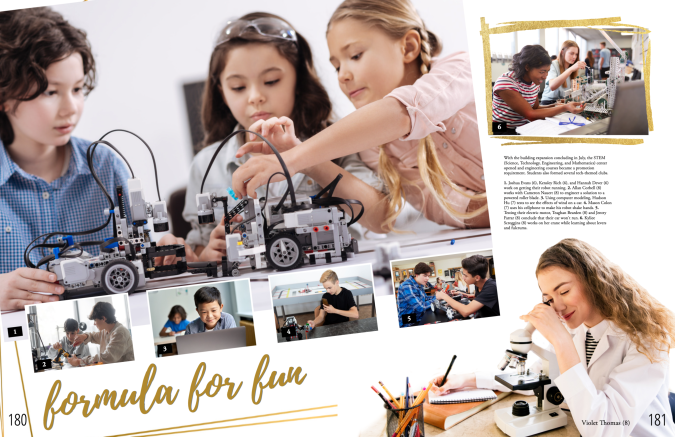
STEM headlines
- Calculating the Memories
- Chart a Force
- [Mascots] Count Get Enough
- Easy as Pi
- Formula for Fun
- Here Comes the Sum
- In Our Prime
- Make Sum Noise
- Massing Around
- On this Equation
- Pi-ous Celebration
- Rule for Thought
- Square One: [Year]
- Squaring Is Caring
- The Final Equation
- The Sum of [Year]
- Up and Atom
- Write Angle
Humanities headlines
- Act your Page
- Anything Prose
- Blurb the Line
- Bookmark my Words
- Born and Read
- Bursting at the Themes
- Do the Myth
- Full Theme Ahead
- Get Booked On
- Go for Baroque
- Move in the Right Direction
- Plot it Down
- Prose and Cons
- A Rhyme a Dozen
- Setting Pretty
- Strike a Prose
- The Write Stuff
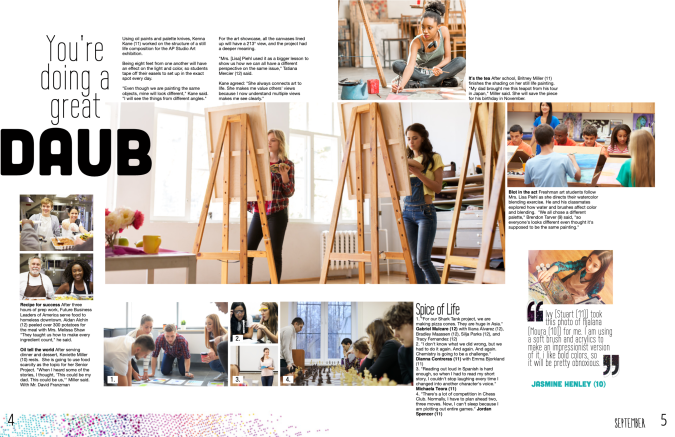
Arts headlines
- All Hands on Deco
- All Strings Considered
- Band New
- Band Over Backwards
- Bright of Passage
- Brush with Greatness
- Canvas of the Year
- Choral High Ground
- Emboss Level
- Face the Music
- Fair and Snare
- Fluid for Thought
- Hip Hop to It
- Horn to Fly
- Rhythm and Reflection
- Size the Day
- Soul in One
- The Stage is Set
Senior section headlines
- A Class Act
- A Degree of Fun
- From Student to Scholar
- Looking Grad-ulous
- Making Moves
- Onward and Upward
- Rising to the Challenge
- Stepping Into New Horizons
- Taking Flight (good for a bird mascot)
- The Final Exam
- The Final Lap of our Academic Race
- The Future Begins

This is the trick to a great yearbook principal message
When it comes to the yearbook principal message, there’s a trick we often see with the best ones:
Involvement from the yearbook adviser.
We know that might sound a little odd, since your principal is the head honcho, and, let’s face it, none of us like to tell our bosses what to do (#Awkward). But the trick to a really good yearbook principal message isn’t just to let your principal write whatever it is he or she feels like. It’s making sure you help shape that message.
Think about it: You’re the expert on the yearbook. You know the book’s theme, and how it’s being carried through on all the pages. Your principal doesn’t. That makes your viewpoint a good one for the principal to hear. Look, we know that every yearbook adviser is going to feel a different level of comfort when it comes to telling your principal what to write. If that’s not for you, there’s another way to help. Helping them how to shape what they want to say. And that’s what the rest of this post is about.
Read on, and we’ll explore the most important aspects to writing a good yearbook principal message.
6 tips for writing a better yearbook principal message
1. Start with a story.
Did you know that there’s science behind storytelling? Seriously. Our brain actually reacts differently when it receives information as plain ol’ data than it does when information is delivered in a story-like format. That doesn’t mean a principal’s message needs to start with “Once upon a time…”It simply means that using more adjectives, including metaphors and sharing personal anecdotes are techniques that help a message connect with the reader—so start your message with a story.
2. Connect to the theme.
There is a lot going on at your school, right? That’s exactly why your yearbook has a theme. The yearbook theme serves as the unifier between all the clubs, activities, sports and classes that take place throughout the year.So it makes sense that, as the leader of the school, your message both unifies and sets the stage for that theme. Plus, tapping into the theme is a way to recognize the hard work of your yearbook team -- and a subtle way of supporting them.
3. Write like you talk.
This is your principal's message, and it should sound like them. Don’t be afraid to let your personality shine.Avoid long words, formalities and clichés that wouldn’t be part of your vocabulary in everyday conversation. One of the benefits of keeping your language simple is that it will be easier for readers to remember and connect with your message. And that’s exactly what you want.
4. Show gratitude.
Remember to thank the people who worked really hard to make the yearbook—and the school year—amazing. This recognition of a job well done goes a long way, especially if you rely on a group of volunteers throughout the school year.
5. Be concise.
Attention spans are shorter than ever. For most people that means shorter than a goldfish.There’s a better chance that people will read your message if they can see that it won’t take much of their time.
6. Find an editor.
This is where you, the yearbook adviser, get to play a really big role again.Once your principal has created a message they're happy with, it's your turn to step in, and give it a good edit. Check for the other five tips, then proofread it. Doing so will ensure that their message is clear and error-free. It's the best way to make your principal's message stand out (and to save them unwanted embarrassment).Your yearbook principal message isn't just the responsibility of the principal. And it's not just letting your principal write whatever it is he or she feels like. You need to step in and help shape that message. If you use these tips, your principal will deliver his or her message better than they would have done on their own. And that'll make you a hero.
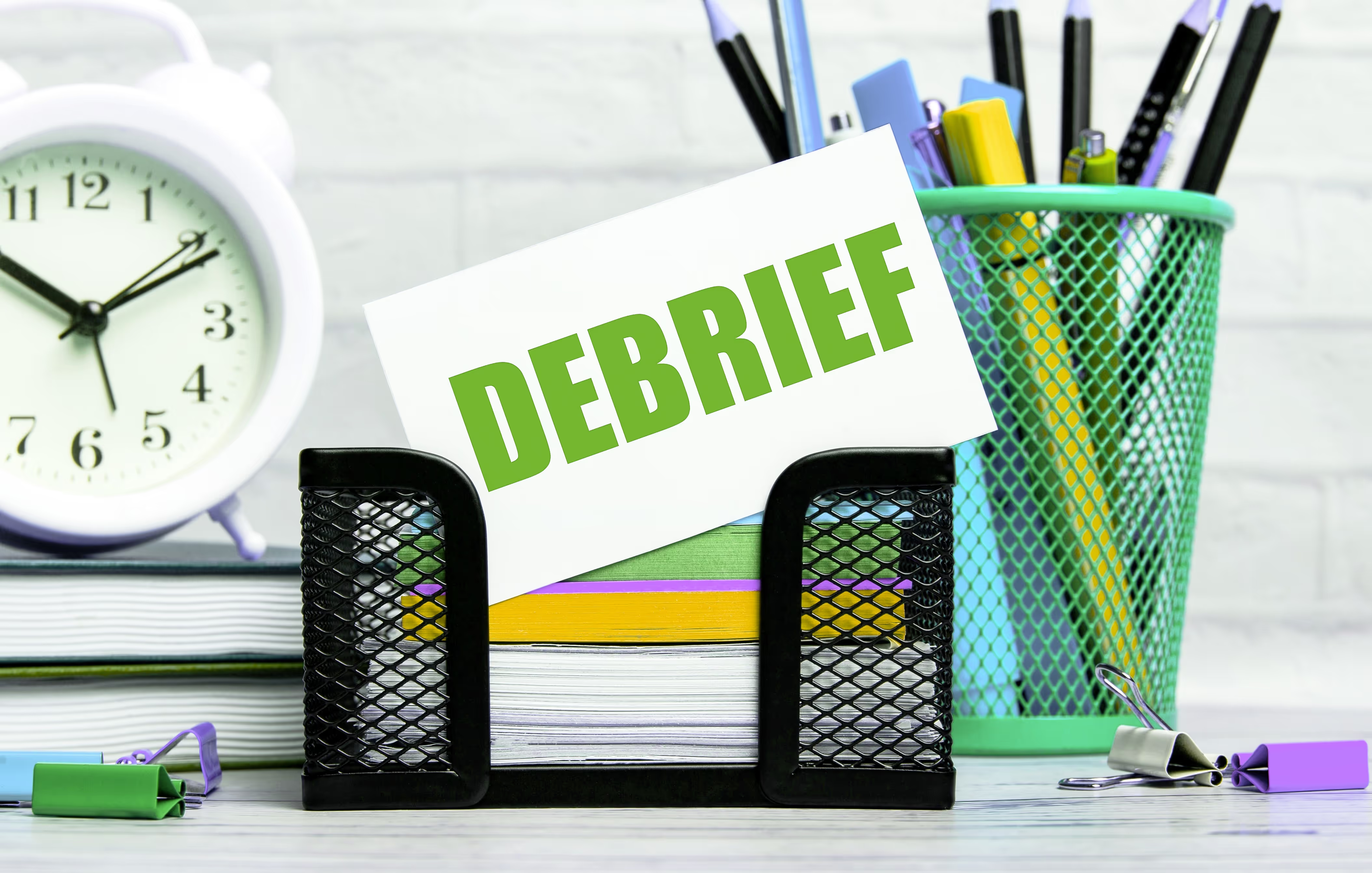
Yearbook debriefing: a summer reflection
Now that your yearbook is a wrap and there’s nothing but sunshine ahead, it’s nice to take some time to reflect on your achievement. You may not want to spend all summer analyzing your yearbook (and who does?), but here are some quick "yearbook debriefing" tasks to help set yourself up for the new school year:
Bask in your success.
You did it! We hope you feel accomplished, proud, and gratified. First and foremost, this is the perfect time to round up your team to celebrate a job well done. Whether it’s a picnic in the park, a backyard super soaker battle, a trip to a local amusement park, or a pizza party at the pool, gathering everyone together is a great way to close this chapter (pun intended!).
A shared celebration is a morale boost, a “thank you,” and a fantastic way to show everyone how fun yearbooking is as you ride that wave of camaraderie into the upcoming year.
Solicit and evaluate feedback.
Whether utilizing an informal compilation of comments or a more formal survey or meeting, it’s helpful to evaluate the yearbook from the experience of your school community. This process can include everything from design and content to distribution and will be invaluable during your yearbook debriefing.
While we all would prefer kudos to criticism (here are some tips for dealing with complaints), your audience's honest feedback is crucial to improving and enhancing your yearbook program. Additionally, considering suggestions and allowing people to feel heard goes a long way toward creating a solid yearbook culture.
Analyze growth opportunities.
When doing your yearbook debriefing, looking for ways to refine your process is essential. Did you and your team encounter any challenges building or marketing your book? Can you enhance your collaboration process? Is there room for improvement in your workflow or organization? If your timeline proved challenging, have you considered a company that allows you to control your deadline?
Lay the fall foundation.
Remember to take a few minutes to set yourself up for fall success by verifying details with your publisher (e.g., logging in to confirm your account for next school year). And if you would like to spend some time planning for your next yearbook over the summer, here are three steps to kick off another fantastic year of capturing your school’s spirit. Here’s hoping you can do all your prep work poolside!

How to write a yearbook story people will love to read
A good yearbook staff needs to know how to write a yearbook story, but that can be easier said than done. After all, writing something that people enjoy reading takes a lot of practice—even more than yearbook design and photography. And by the time you're done working with your students on all the other aspects of creating a yearbook, well, there's not a whole bunch of time left to spend practicing how to write a yearbook story.
That's why we wrote this post.
In it, you'll learn five easy-to-follow tips you and your yearbook staff can start using to improve all the copy in your yearbook, especially the copy that makes up your yearbook stories. We have pointers on improving headlines, writing ledes, finding your voice, and laying out your yearbook stories.
Before we get to those tips, though, we want to spend a minute on the big reason knowing how to write a yearbook story is important. And that's this: If you overlook your yearbook copy in favor of bold designs and strong photos, your yearbook is incomplete. That's because your written yearbook stories put memories in context. They tie your narrative together. They make readers want to spend more time on your pages. They make readers revisit your yearbook over time.
Let's get on with those tips, then, shall we?
5 tips for how to write a yearbook story
1. Power up your headline
A strong headline can make or break your yearbook story. Headlines draw readers in with a promise or a bold claim. They hold attention and create anticipation. The best yearbook story headlines are:
- Short – they quickly summarize the content to come
- Specific – they tell readers exactly what to expect
- Standalone – they make a statement on their own
- Special – they are unique, powerful and interesting
Headlines have the power to transform a mediocre story into something truly spectacular.
For example, instead of using a straightforward headline such as:
"The Blue Hawks’ Memorable Season,"
add excitement with a headline that pops:
"The Blue Hawks Swoop In For an End-of-Season Win!"
The second option ups the emotion while giving readers a reason to find out more about how the Blue Hawks overcame challenges during the season. You can even try to switch up the format of your story by using a “list headline”, such as:
"5 Times the Blue Hawks Surprised Fans This Season"
Or:
"10 Reasons We Love Cheering for Our Blue Hawks"
Your yearbook story’s headline not only sets reader expectations, but also sets the tone for your following narrative. Which leads us to…
2. Take a strong lede
Lede is a journalism term for the opening section of a news story. (Need a primer on yearbook terms? Check out this blog post and interactive quiz to keep fresh.) Reporters start their articles with the most critical information, enticing readers to continue and ensuring readers grasp the story’s main message. Think about this when you write your yearbook story’s introduction. The beginning of your story should:
- Deliver on the promise made in your headline
- Give readers the critical information they need
- Introduce action, conflict or emotion
- Prompt readers to continue to learn more
Need an example? Go back to the lede of this blog post. In it, we tell you exactly why yearbook story content is critical, and how this article will help you write better stories. (If you’re reading this right now, our lede worked!)
3. Be an active writer
To write active and entertaining yearbook stories, you need to use active and entertaining language. And this means writing in the active voice. For those who need a refresher, active voice is when the subject of a sentence is doing the action, while passive voice is when the subject of a sentence is being acted upon. An example of passive voice:
"The team was cheered on by hundreds of fans."
This sentence falls flat, because the fans are acting upon the subject (the team). It’s easy to switch to active voice, however:
"Hundreds of fans cheered on the team."
In this new sentence, the subject of the sentence (hundreds of fans) performs the action.
Another way to keep your writing active is to use strong verbs. Verbs are words used to describe an action – and they can be strong or weak. “To be” verbs such as “am, is, are, was, were” often weaken a sentence. Here’s an example of a weak verb at play:
"The debate team is responsible for researching their topics."
Here’s the same sentence, using a strong verb:
"The debate team investigates their topics."
Strong verbs convey more meaning than weak verbs, and help bring a yearbook story to life.
4. Give it some voice
Quotes and testimonials from students, parents, faculty and staff are great ways to bring both personality and personal meaning to your yearbook stories. Whenever possible, include statements from the individuals who were directly involved in the stories you’re recapping.
- Interview the swimming star on her big win.
- Ask a science student about his favorite experiment.
- Talk to a teacher about how her students changed over the year.
These individual moments will give your yearbook stories more context and emotion.
5. Design your yearbook copy
While you may think of copy and design as two separate entities, design plays an important role in your copy's readability. The right fonts, layout and sentence structure all work together to move a reader easily and comfortably through a yearbook story. Here are some ways to better design your content:
- Keep sentences and paragraphs short.
- Cut out unnecessary words.
- Add subheads to divide stories into sections.
- Break up text with call-out quotations or facts.
- Use bullet points to list short moments or stories.
- Keep fonts simple – select one font style for headlines and one for body copy.
Finally, in both content and general page design, be aware of white space. Don’t fill every blank spot with text or imagery; let your story breathe. Take time to write focused, meaningful and engaging yearbook stories. You'll end up with a stronger picture of your school year.
When it comes to creating a yearbook, knowing how to write a yearbook story is important stuff. Even if great writing takes a lot of practice, there are some easy-to-follow tips that will get you closer by the day. Follow them, and your yearbook is sure to succeed.

The write stuff
No one reads yearbook stories. Sound familiar? I felt that way in my first five years advising. Focusing on photojournalism was almost an act of rebellion against the genius who mentored me in my high school’s newsroom. Yes, pictures are worth a thousand words and all that. By adding writing to your yearbook pages, you give names to faces and intent to actions. It’s more than so-and-so on the thing doing the thing; it’s context and clarity. It's a change for the better.
Copy as design
I’ve said it for years because my aforementioned high school adviser brainwashed me (in a good way): Content drives design. If you plan on increasing your yearbook’s written content, learn how to design with copy.
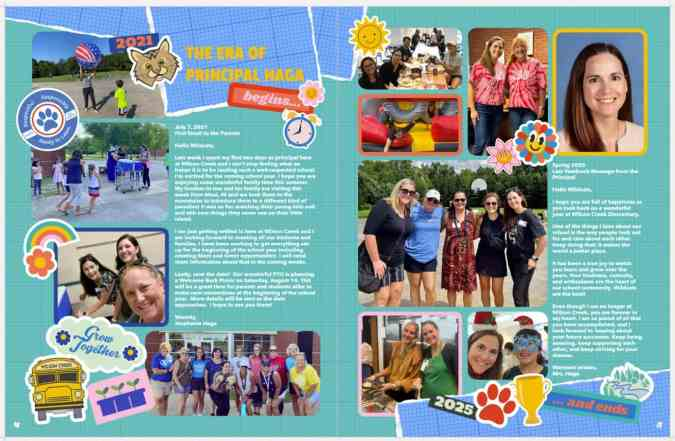
Headlines
Headlines are a great way to connect yearbook spreads back to the theme. On a spread about robotics, push yourself to make the main verbal entry point read more than “Robotics.” Your headline font, weight, color, and placement are just as important as the dominant photo.
Captions and stories
While not every topic may need a story, (nearly) every photo deserves a caption. Captions are entry-level writing opportunities. Compare the two spreads below. They are from the same yearbook. One is captions only; the other has a story.
The captions are close to the photos they complement. The story connects to the headline and subheadline.
How to introduce writing to the yearbook
As an adult, it can be tough to approach another adult and have a conversation (cool mom at the playground, I’m looking at you). Likewise, getting students to approach their peers isn’t the easiest skill to teach. As with all skills, take the easy +1 approach: start small, master that skill, and add another.
A progression, like the one below, builds confidence while building familiarity.
1. Introduce a question of the day (QOTD)
The heading says it all. Advisers or the editorial board select a question, and yearbook students ask four non-yearbook students the QOTD.
Yearbook creators are encouraged to start with their peer groups and branch out. The only caveat is that they cannot ask a student a QOTD twice until everyone has had a chance. No repeats. You can track this with a BOLO (Be on the Lookout) board, via a Google Sheet fed by a Google Form, or with your roster.
Do the math with me for a second: if six yearbook students each interviewed four students daily, that would be 120 student voices added to your yearbook in a week. With a larger staff of 18, that’s 360 new voices. Use these as Q&A moments in your portrait section or sidebars through athletics, arts, and student life spreads.
With those figures, you could get a meaningful quote from nearly everyone on campus each quarter.
2. Practice interviewing in class weekly
Repetition builds skills, and we educators know that. In the yearbook classroom or club space, the work of photoshoots, layout design, and marketing sometimes overshadows the process of creating. Take time to teach, practice, and evaluate your team’s skills. Here are a few ideas:
3. Take it to the street!
The key to a good yearbook interview is to have good questions. While there are hundreds of lists on the interwebs (we list some of our favs below), tailoring the interview to the subject will always give you the best material.
The best way to prep is to craft questions using the Five Common Topics: definition, comparison, relationship, circumstance, and testimony.
Once you have a list of questions—“Give me a quote for the yearbook” does not count—ask them!
The late Casey Nicols inspired a love of focus groups in me. As a journalism mentor, he encouraged me to bring in clubs or teams at lunchtime and interview the group. There was strength in numbers for them, as interviews were new for our yearbook staff. And our staff received some of the best quotes because they would play off each other.
As a result, their writing became interesting. Students read it. It became the expectation.
4. Start small
Remember, easy +1. If there is no writing in your yearbook, add captions. Play with sentence structure so it’s not always subject-verb-adverb. Add a prepositional opener. Make it a complex sentence. Then
You don’t have to do it all. Ever. Tell your community’s story your way.
Help with interview questions
Use these lists of interview questions for creating QOTD, practice interviews, and as launch pads for longer form copy.
You can even have students rank their favorite and least favorite questions. Make sure they have a reason why. Re-write the “bad” questions and craft follow-ups for the helpful ones.

Participate in National Scholastic Journalism Week 2022
Celebrating the students on campus—all of them—is what we love most about inclusive yearbooks. This year, the theme for Scholastic Journalism Week is “Amplifying Voices.” If you’re participating, or here for inspiration, here are some ways to integrate Scholastic Journalism Week into your school and get more students heard.
Monday: participate in #makingconnections
From PTA/PTO councils to journalism teachers, there are people willing to share best practices. It’s one of the reasons we love to share about Yearbook Heroes. Identify:
- Who is doing what I want to do?
- What can I learn from them?
- Who can inspire my students?
- What similar stories do we have on campus?
- Who is disconnected? How do we amplify their voice?
You may be the one to teach others—share your story!
Tuesday: #teachmeTuesday
Because this is a celebration of scholastic journalism, take some time to teach journalism. Start with a writing lesson or practice interviewing. Collectively, you could tackle intorduce media literacy or a difficult reporting assignment such as covering the recent wildfires or tornadoes.
Wednesday: be about the business of #sharingstories
Take advantage of our pre-planned social media calendar to jumpstart your shares. Make sure your posts feature diverse grades, activities, and subjects. This way, you show students the value individuals make to the whole of your school community.
In your yearbook, you may want to include quote packages or fill-ins to amplify voices and give students the means to share their stories.
Thursday: always fit in a #throwback
Throwback Thursdays are fun because you can do nearly anything:
- Feature stories from alumni (don’t forget to use their yearbook photo!)
- Collaborate with a social science teacher on campus to integrate journalism's impact on history
- Print and display favorite yearbook spreads or covers from the previous years
Friday: #democracyinaction
JEA encourages schools to use the last day of Scholastic Journalism Week to share how their schools and communities value the freedom of the press. Here are some ideas on how to participate:
Elementary schools
- Memorize the First Amendment
- Start student-led media projects
Middle and high schools
- Have a conversation with school administration over the Principal’s Guide for Scholastic Journalism
- Learn to evaluate sources
- Memorize the First Amendment
Your participation in Scholastic Journalism Week 2022, be it one day or all five, will show your journalism students their voices matter as well as the responsibility they have as campus advocates to be the voice of others.

Before teaching yearbook writing, read these 7 stories
One of the best ways to get better at writing is to read great writing. Similarly, the only way to teach students how to create exceptional yearbook copy is to absorb and share as much great writing as you possibly can. Here’s why: Good writing serves as a model of excellence for flourishing writers. It has the ability to teach and inspire at the same time. (Talk about powerful stuff.) Encouraging your staff to spend time reading—and imitating—good writing can drastically improve the quality of the yearbook copy they produce for your book. If your goal is to include yearbook stories that capture the minds and hearts of your community even more than the photographs do, reading and discussing great nonfiction is key. Ideally, you’ll be doing that before, during, and after a yearbook writing assignment, but we get that there are other parts of the book to cover, as well.
In any event, we figured we’d give your reading list a jump start by pulling together seven pieces of truly exceptional nonfiction. It’s probably worth noting that none of these pieces appeared in a yearbook. And there’s a reason for that. From saving a local library that has served a downtrodden community’s lone bright spot, to exploring the philosophical underpinnings of cooking live lobsters, these pieces offer young writers a guide to finding their voice and inspiration to chase a great story. They also happen to give you some great teaching material. Besides, we’ll pretty much guarantee you’ll walk away from each piece with beautiful prose flitting about your head, and tears (of joy, laughter or sadness) in your eyes.
7 stories to help teach better yearbook writing
1. “The North West London Blues,” by Zadie Smith
You need to read this because…
Zadie Smith is an excellent writer and one of the most influential writers in Britain (which is pretty much the same as saying she’s one of the most influential writers in the world, because, come on, we all know how much the Brits love to write). “The North West London Blues” is a piece in defense of the Willisden Green Library, a place she frequented as a child and that clearly functioned as a cornerstone of the community. Set to close and make way for commercial endeavours, the story is built around a community’s peaceful protest of the library’s closing.
Smith talks through her own experience with and passion for the library, generally speaking, as a necessary component of any community, and does so with beautiful prose. Her sprawling narrative introduction gives way to highly descriptive writing that weaves personal experience with an argumentative streak yielding a piece of writing your staff will love. Stylistically, Smith deploys parentheticals throughout the piece in an interesting way, using them to insert long swaths of supporting information, as if the speaker grabbed a snippet from a pertinent Wikipedia page.
Share this story with students who might enjoy weaving elements of personal narrative and rich description in a piece shedding light on a serious economic or social problem impacting the school community.
A Brief Snippet of What Makes this Story Great:
“Well-run libraries are filled with people because what a good library offers cannot be easily found elsewhere: an indoor public space in which you do not have to buy anything in order to stay.”
Read “The North West London Blues” here
2. “Taylor Swift Runs the World,” by Chuck Klosterman
You need to read this because…
Since the likelihood of your yearbook including a profile of some sort is rather high, knowing what a great one looks like is imperative. A profile shouldn’t be an all-out fluff piece, an unabashed celebration of an individual. But writing something that allows readers to get a glimpse of the subject without deifying them can be quite difficult. It requires tact, a strong voice, and the ability to sift through facts and quotes, determining what matters most before spinning it into a cohesive story.
“Taylor Swift Runs the World” is an exceptional example of a profile piece. Klosterman’s patented style (gratuitous hair metal references and self deprecation) makes for a great read, and the stark contrast it creates when compared to the version of Swift depicted creates great tension throughout the piece. Chuck Klosterman is a criminally underrated national treasure. The guy’s hilarious, impossibly smart, and writes with a truly unique voice.
A Brief Snippet of What Makes this Story Great:
“There’s simply no antecedent for this kind of career: a cross-genre, youth-oriented, critically acclaimed colossus based entirely on the intuitive songwriting merits of a single female artist. It’s as if mid-period Garth Brooks was also early Liz Phair, minus the hat and the swearing. As a phenomenon, it’s absolutely new.”
Read “Taylor Swift Runs the World” here
3. “Consider the Lobster,” by David Foster Wallace
You need to read this because…
“Consider the Lobster” is probably more of an assignment for an AP English class, where you’d discuss the underlying philosophical argument, and take turns wrestling with the obscure language and the paragraph-length tangential deep dives. You can read the essay’s eight pages over and over and come away with your mind blown every time.
David Foster Wallace is (in)arguably the most prolific essayist of the 90’s/aughts. His footnotes are often more illuminating (and more wonderfully written) than entire volumes produced by his peers. This essay is an interesting, off-kilter entrypoint into existential philosophy and the opulent-ish world of gourmandizing. Share this with your staff as encouragement to find their voice (no matter how “out there” it might be). Just be sure your staff doesn’t try too hard to emulate DFW: it’s impossible!
A Brief Snippet of What Makes this Story Great:
“Is it all right to boil a sentient creature alive just for our gustatory pleasure? A related set of concerns: Is the previous question irksomely PC or sentimental? What does “all right” even mean in this context? Is it all just a matter of individual choice?”
Read “Consider the Lobster” here
4. “The life and times of Strider Wolf,” by Sarah Schweitzer
You need to read this because…
If this one doesn’t make you cry, you’re wrong. Written over the span of months, Boston Globe reporter Sarah Schweitzer’s soul-wrenching story runs the gamut, detailing the life and circumstances of a young boy from rural Maine named Strider Wolf. A victim of horrific abuse, abandoned by his parents, and raised by his grandparents, Strider somehow manages to emit glimpses of optimism and happiness on a daily basis.
This is a phenomenal example of telling an utterly tragic story with tact and beautiful prose, and the perfect way to introduce your staff to emotionally impactful writing that isn’t overdone. An added bonus: the accompanying photography won a Pulitzer, so be sure to share this one with your whole staff.
A Brief Snippet of What Makes this Story Great:
“A few weeks later, shortly before the end of school, Strider sat alone, under a DARE sign, curled into a wall alcove. The lunch ladies in blue smocks had piled his tray with potatoes and carrots and chocolate milk, but he picked only at a package of Pillsbury mini-bagels. It was grab bag day. A dollar bought a brown paper bag of goodies, like pencils and erasers. Two mothers from the PTO were stuffing bags at the table over from him. Lanette had told him that morning she didn’t have a dollar.”
Read “The life and times of Strider Wolf” here
5. “Friday Night Lights,” by Buzz Bissinger
You need to read this because…
It revolutionized the way people write about sports. It’s a sociological study of small-town Texas in the late eighties. You loved the TV show. Football season is over. Need I go on? Bissinger’s essay (and book, if you haven’t read it) chronicle a Texas high school football team and the surrounding community in the late 1980’s. An outsider (from Philadelphia), Bissinger became a part of Odessa, learning the town's racial, social, and economic machinations, and penned his book in a way that tackles (had to) these themes very much head on.
While it’s unlikely your yearbook will feature pieces riddled with racial undertones, Bissinger’s ability to write about stories that didn’t take place on the field—as well as the actual accounts of football being played—in “Friday Night Lights” are excellent examples for your staff to check out.
A Brief Snippet of What Makes this Story Great:
“Crousen was saddened and dismayed. He couldn't help but wonder if Boobie, because of his natural athletic ability, had gotten too used to having everything handed to him.This August, while other college players prepared for the beginning of football practice, Boobie stood in front of his home in the Southside, chatting quietly with members of his family. It was then that his cousin Jodie found out that Boobie wasn't going back to Ranger and would sit out a year. She was shocked and worried."You're just going to rust up, "she said."It ain't gonna happen," replied Boobie, for he knew better. "It's a God-given talent."
Read “Friday Night Lights” here
6. “The Last American Man” by Elizabeth Gilbert
You need to read this because…
Don’t be shocked if you read this piece by Eat, Pray, Love author Elizabeth Gilbert and decide to move to the heart of Appalachia to build yourself a yurt and start clearing trees for fields. “The Last American Man” is another profile, though on the opposite end of the spectrum; instead of the subject being someone of unimaginable fame, Gilbert details the life and philosophy of a man who has chosen to eschew mainstream society, instead preferring the simplicity and joy of self-sufficiency (think Chris McCandless with more know-how and much better luck).
If you have a staff that swears its high school is so boring they’ll never be able to find a unique story inside its four walls, show them this. Gilbert proves that anyone, anywhere can be fascinating. Warning: There are a handful of F-bombs in the introductory paragraphs.
A Brief Snippet of What Makes this Story Great:
“Eustace hated to blow its beautiful head off, so he took his knife from his belt and stabbed into the jugular vein. Up came the buck, very much alive, whipping its rack of antlers. Eustace clung to the antlers, still holding his knife, and the two began a wrestling match, thrashing through the brush, rolling down the hill, the buck lunging, Eustace trying to deflect its heavy antlers into trees and rocks. Finally, he let go with one hand and sliced his knife completely across the buck's neck, gashing open veins, arteries and windpipe. But the buck kept fighting, until Eustace ground its face into the dirt, kneeling on its head and suffocating the dying creature.That's what living in the woods means.”
Read “The Last American Man” here
7. “Death of an Innocent,” by Jon Krakauer
You need to read this because…
A lot of high school students read Jon Krakauer’s Into the Wild. It’s a classroom classic; why not show your staff the essay from which it spawned? “Death of an Innocent” manages to combine a series of interviews, passages from McCandless’ own journal, scientific research, and even snippets of Krakauer’s own time spent wandering after college, to create a fascinating piece. Pay particularly close attention to the way Chris McCandless is characterized. Is his rugged individualism heralded, or is he painted as a brash young man woefully under-equipped for the circumstances he sought out? Is there even a definitive answer to this question?
A Brief Snippet of What Makes this Story Great:
“His education had been paid for by a college fund established by his parents; there was some dollars 20,000 in this account at the time of his graduation, money his parents thought he intended to use for law school. Instead, he donated the entire sum to Oxfam. Then, without notifying any friends or family members, he loaded all his belongings into a decrepit yellow Datsun and headed west, without an itinerary. Chris McCandless intended to invent a new life for himself, one in which he would be free to wallow in unfiltered experience.”
Read “Death of an Innocent” here
Read them. Learn from them. Teach with them. Talk through style and technique, pointing out the rhetorical devices and artistic flourishes that your young writers might incorporate into their yearbook writing. Most importantly, though: enjoy.

Yearbook proofing tools
Raise your hand if you do your best proofing after the yearbook goes to print. We've all had that cringe moment when you notice two baseball players' names interchanged in the sports section or the student who joined the second semester flowed with the wrong class. We can all agree: proofing is critical for the yearbook creation process. Consistency and the proper tools will help you ensure no mistakes slip through the cracks.
One-time: printed proof
Would you like a copy of your yearbook before distribution day to check your fonts, colors, layout, cover texture, and photo quality? We've got you.
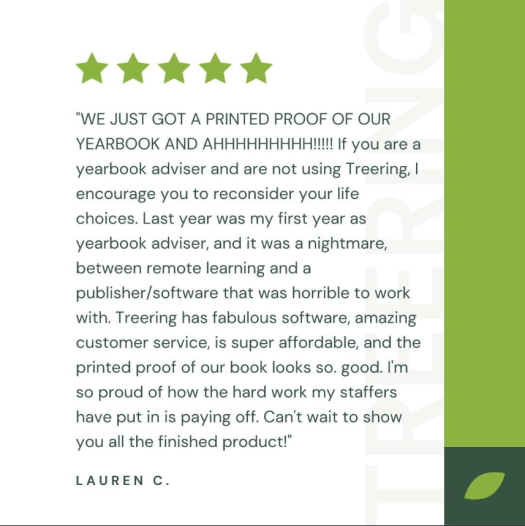
Once your yearbook is approximately 70% complete, order a printed proof of your yearbook to review the following:
- Cover alignment and bleed
- Portraits (accuracy, name size, and font)
- Gutter
- Bleed and margins
- Font choices, sizes, and colors
- Background contrast
- Spelling and attribution
- Photo clarity and color

Monthly: use PDF proofs
Print out a hard copy. Errors that are missed on the screen often jump out on paper. Create PDF proofs of class, event, club, and athletic pages to provide to the appropriate stakeholders for their review. Ask them:
- Is the content accurate? Is anything missing?
- Are names spelled correctly and referencing the correct person?
- Do these photos accurately represent the page's content and our student body?
Remember they need some time to review it, and should it require changes, you will need time to incorporate them.

Text proofreading tips
Read all captions, pull quotes, and headlines out loud. It may feel silly, and once you do it, you will see and hear the value:
- Tone, word choice, and sentence structure pop when you read them out loud
- If all your writing sounds the same, you may want to mix up sentence structure or type
Proofing yearbook quotes
Proofing is essential if your school uses expanded captions, pull quotes, or <gasp> senior quotes. A transcription tool for interviews, such as Otter.ai, which integrates with Google Docs, is handy for recording conversations.
Quotes must not be taken out of context. We do not alter quotations, even to correct grammatical errors or word usage. If a quotation is flawed because of grammar or lack of clarity, it may be paraphrased in a way that is completely true to the original quote. If a quote's meaning is too murky to be paraphrased accurately, it should not be used. Ellipses should be used rarely and must not alter the speaker’s meaning.
AP Style Guide
(Here's an article from CBS News and one from Slate that addresses language learners to review with your students.)
Sharing is caring: use printed proofs to tease the book
This isn't the first time we’ll make this suggestion, and it won't be the last.
Ongoing: rubrics and checklists
The best time to begin proofing yearbook spreads is after you’ve finished each page and well before you need to go to print. Informal editing can happen on screen with an editor or adviser. We also highly recommend peer editing on a projector with the whole team. Use a rubric to help guide the conversation.

Proofing and editing aren't a one-and-done thing. (Sorry not sorry!) It takes time to craft the perfect story and to create a solid layout from scratch. And if DIY is not your thing, the thousands of layout templates in the Treering library are at your disposal.



